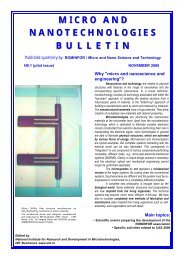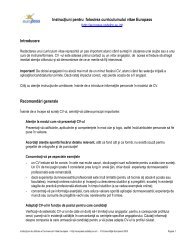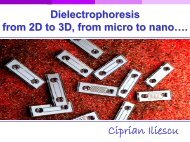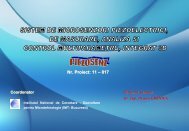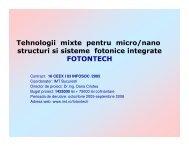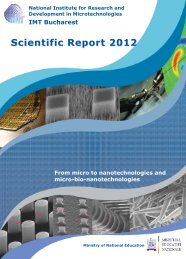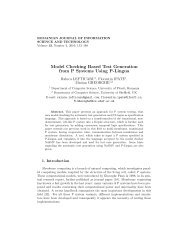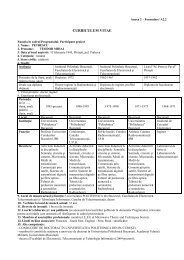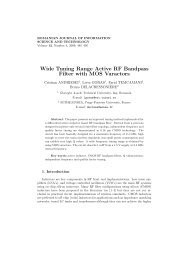SnO2 Thin Films Prepared by Sol Gel Method for âHoneycomb ... - IMT
SnO2 Thin Films Prepared by Sol Gel Method for âHoneycomb ... - IMT
SnO2 Thin Films Prepared by Sol Gel Method for âHoneycomb ... - IMT
- No tags were found...
You also want an ePaper? Increase the reach of your titles
YUMPU automatically turns print PDFs into web optimized ePapers that Google loves.
ROMANIAN JOURNAL OF INFORMATIONSCIENCE AND TECHNOLOGYVolume 10, Number 1, 2007, 25–33SnO 2 <strong>Thin</strong> <strong>Films</strong> <strong>Prepared</strong><strong>by</strong> <strong>Sol</strong> <strong>Gel</strong> <strong>Method</strong> <strong>for</strong> “Honeycomb”Textured Silicon <strong>Sol</strong>ar CellsE. MANEA 1 , E. BUDIANU 1 , M. PURICA 1 , C. PODARU 1 ,A. POPESCU 1 , I. CERNICA 1 , F. BABARADA 2 ,C.C. PARVULESCU 21 National Institute <strong>for</strong> Research and Development in Microtechnologies,Erou Iancu Nicolae, Str.126A, PO Box 38-160, 72996 Bucharest, RomaniaE-mail: elenam@imt.ro2 Faculty of Electronic and Telecommunication,“Politehnica” University of Bucharest RomaniaAbstract. This paper presents a new silicon solar cell structure obtained<strong>by</strong> texturisation of the front surface using silicon micromachining technologies.The textured surface of the solar cell reduces frontal reflectivity, in order toconsequently obtain the lowest possible reflectance. Heterojunction SnO 2 :In/nsilicon substrate (“honeycomb” textured) solar cells were manufactured <strong>by</strong> thesol gel method over textured p and n-type single CZ crystal silicon substratewafers, with orientation, rejected from the MOS integrated technologyprocess. The obtained textured structures were studied <strong>by</strong> SEM and <strong>by</strong> opticaland spectrophotometric measurements.Keywords: Silicon-1; Texturisation-2; Light trapping-3; <strong>Sol</strong>ar Cells-4; solgelmethod-5.1. IntroductionThe sol-gel method, may be considered an adequate procedure <strong>for</strong> high purityand homogeneous films preparation, based on the hydrolysis and polycondensation ofmetal organic precursors, such as metal alkoxides. These last years, this depositiontechnique has won the scientific interest due to the fact that its advantage mainly
26 E. Manea et al.related to low temperature of processing, simple and cheap technological equipment,homogeneity on the molecular level in solution allowing a stoechiometry and an excellentcompositional control and ability to coat large and complex area substrates.The sol-gel process also offers a versatile method <strong>for</strong> the preparation of opticalquality films with controlled refractive indices and small thicknesses, allowing ananoscale control of the film structure.These last few years, tin oxide (SnO 2 )/silicon (Si) and tin doped indium oxide(In 2 O 3 :Sn)/Si solar cells have been proposed <strong>by</strong> some authors [2, 3, 4] as low costphotovoltaic devices.The cost reduction obviously will be in the junction <strong>for</strong>mation steps and also ineliminating the anti-reflection layer. Tin oxide, in the <strong>for</strong>m of thin films is transparentin the visible region of the solar spectrum, there<strong>for</strong>e, acts as a window <strong>for</strong> sunlight. Atsome wavelengths, the refractive indices of SnO 2 and Si match, SnO 2 acts there<strong>for</strong>e,as an antireflection coating [5].The doping of indium in SnO 2 has been carried out to reduce the sheet resistanceand to increase the transparency of the thin film.In the present investigation the combined effect of the silicon textured surface, continuityand uni<strong>for</strong>mity of indium doped SnO 2 and SnO 2 layers deposited on texturedsurface of solar cells leads to increasing solar cell efficiency.2. Experimental details<strong>Sol</strong>ar cells technology, including surface microtexturisation of monocrystalline silicon,is based on the integrated circuits planar technology. Front surface texturingof single crystalline silicon cells depends on the etching solution, on the crystallographyorientation of silicon wafers and the etching mask geometry We used single CZcrystal of p- type silicon wafers of thickness 0.5 mm with orientation, rejectedfrom the MOS integrated technology process. Monocrystalline silicon wafers surfacemicrofabrication was per<strong>for</strong>med using MEMS technology. The homogeneous and highoptical transparent SnO 2 and SnO 2 doped with indium layers were obtained at roomtemperature <strong>by</strong> spin-coating(at 3 000 rpm <strong>for</strong> 30 s) from a 0.2 µm filtered solution.The p-Si wafers are initially thermal oxidated at 1 100 ◦ C, resulting in a 1200nmSiO 2 thin film. This layer was used as an etching mask. For the back contact of thewafer a p + high doped layer was made <strong>by</strong> diffusion from a solid source B + . A 620 nmthickness SiO 2 layer growth, used as mask-layer <strong>for</strong> the next steps, was obtained <strong>by</strong>oxidation at 1 000 ◦ C during the diffusion of boron process. Microfabrication of thewafer surface (texturisation) was per<strong>for</strong>med <strong>by</strong> a photolithography process based onpositive photoresist. The windows opened in the thick oxide (1 200 nm) are locatedin the broad band between the contact areas. We patterned holes (4 µm diameter)in silicon dioxide, positioned in the angles of the equilateral triangle, with 20 µm webon a 1×1 cm 2 surface, as presented in Figure 1(a) – SEM image and Figure 1(b) –optical image.
SnO 2 <strong>Thin</strong> <strong>Films</strong> <strong>Prepared</strong> <strong>by</strong> <strong>Sol</strong> <strong>Gel</strong> <strong>Method</strong> 27(a)(b)Fig. 1. SEM and optical image of the surface etched in the (HNO 3 :HF:CH 3 COOH-25:1:10) acid solution, general view.Through the window opened in the oxide, silicon has been etched in isotropic solutionto <strong>for</strong>m hexagonal structures with walls providing maximum well packing density.(HNO 3 :HF:CH 3 COOH-25:1:10) have been used <strong>for</strong> silicon isotropic etching in orderto <strong>for</strong>m semi-spherical walls. The moment when these walls touch the neighbor semisphericalwalls, hexagonal structures are <strong>for</strong>med (“honeycomb” textured). The activejunction of the solar cell was obtained <strong>by</strong> diffusion from the POCl 3 liquid source1 050 ◦ C. During the phosphorous diffusion process an antireflective oxide (120 nm)was grown. In this layer, <strong>by</strong> photolithographic technique, contact windows will beopened. A 1 000 nm thickness aluminium film was deposited on both, front and backsideof the wafer <strong>for</strong> the metallic contacts <strong>by</strong> evaporation in high-vacuum equipment.The metal patterning process (metallic line is 60 µm) is per<strong>for</strong>med on the front sideof the wafer.The second device consists in <strong>for</strong>ming a heterojunction of “honeycomb” texturedsilicon substrate (single CZ crystal of n-type silicon wafers of thickness 0.5 mm, with orientation) <strong>by</strong> indium doped SnO 2 and SnO 2 having a high optical transparency.It also serves, at the same time, as a reflecting coating.The homogeneous and transparent indium doped SnO 2 and SnO 2 layers wereobtained at room temperature <strong>by</strong> spin-coating (at 3 000 rpm <strong>for</strong> 30 s) from 0.2 µmfiltered solution on glass and silicon wafer substrates.The solution consists in tin ethylhexanoate (II) (Sigma Aldrich) as precursors,buthanol, CTAB – hexadecyltrimethylammonium bromide (Sigma Aldrich), as solventand InCl 3 as doping agent.After deposition, the SnO 2 single layers were dried <strong>for</strong> 10 min. at 120 ◦ C andvitrified <strong>for</strong> 30 min. at 400 ◦ C in O 2 enhanced synthetic air. A number of three layerswere deposited, at the end the complete structure being annealed at 550 ◦ C <strong>for</strong> 30 min.The annealing temperature also controlled the size of the SnO 2 nanocrystals (to theorder of 4–6 nm).
28 E. Manea et al.Figure 2 shows the scanning electron microscopy (SEM) image of the silicon wafersurface covered with SnO 2 .Figure 2(a) presents a perspective view of the texturized surface, while Figure 2(b)shows a plan view of the same structure. Indium doped (0.5 wt %) tin oxide (SnO 2 :In)film of 134–377 nm thickness, obtained <strong>by</strong> the sol-gel method, after the thermaltreatments.(a)(b)Fig. 2. Scanning electron microscopy (SEM) image of the Si surface covered with SnO 2 .In Figure 3 we can see the SEM image of the cross section through the texturedsurface covered with SnO 2 :In; (a) a plan view and (b) a detail of the structure.(a)(b)Fig. 3. SEM image of the cross section through the texturing surface covered withSnO 2:In/n-Si.
SnO 2 <strong>Thin</strong> <strong>Films</strong> <strong>Prepared</strong> <strong>by</strong> <strong>Sol</strong> <strong>Gel</strong> <strong>Method</strong> 29The influence of number of coatings and number of thermal treatments on theoptical properties of the films was established.The multilayered films are the approximately linear increase in the thickness ofthe coatings with the number of deposition cycles.The refraction index increases with the number of depositions, due to the densificationinduced <strong>by</strong> repeated thermal treatment. It is known that the substratetopography influences the crystallization of the film. The coatings were characterized<strong>by</strong> spectroellipsometry (SE), UV-VIS spectrometry and SEM methods.3. Results and discussions3.1. Optical characterization of the “honeycomb”textured silicon surfaceTo evaluate the contribution of the surface texturisation process to the growth ofabsorbed fraction from incident radiation, we have investigated the surface reflectivityas a function of radiation wavelength <strong>for</strong> “honeycomb” textured and untexturedstructures.In order to have structures realized through the same technological process, rows oftextured structures were placed beside rows of untextured structures on the same siliconwafer. So, the comparison between the characteristics of the two structures typesestablishes the importance of this technological process <strong>for</strong> solar cells per<strong>for</strong>mances.The reflectivity measurements have been per<strong>for</strong>med using a SPECORD M42 spectrophotometerequipped with a special module dedicated to such investigations [6, 7].Figure 4 shows the spectral dependence of reflectivity <strong>for</strong> a “honeycomb” texturedand untextured silicon wafer surface <strong>for</strong> comparison. The data revealed that the radiationlost <strong>by</strong> reflection is significantly lowered (
30 E. Manea et al.3.2. The optical characterization of the doped and undopedSnO 2 thin films deposited <strong>by</strong> sol-gel techniqueThe optical properties were investigated <strong>by</strong> spectrophotometric and ellipsometricmeasurements. The transmission and reflection spectra of the deposited films on glassand on the Si substrate were recorded in the wavelength range from 200 nm to 900 nmusing a SPECORD – M42 double beam spectrophotometer. The transmission <strong>for</strong>undoped and antimony doped tin oxide and thermal treated at 550 ◦ C in O 2 ambientwith the films thickness in the range of 105–125 nm, deposited on transparent glasssubstrate, <strong>by</strong> sol-gel, is shown in Fig. 5.Fig. 5. Transmission spectra of the SnO 2 (doped and undoped) filmswithin the range of 105–125 nm deposited on transparent glass substrate<strong>by</strong> sol-gel technique.The deposited films showed high transmission (over 90%) in the visible and nearinfraredregion and the flat aspect of transmission spectra without interference fringesemphasizes the surface uni<strong>for</strong>mity due to the small crystallite. High optical transparencyof the obtained films demonstrates the applicability of these layers <strong>for</strong> photovoltaicapplications.The thin film reflectivity <strong>for</strong> both doped and undoped SnO 2 thin films depositedon silicon wafers was reduced <strong>by</strong> the heat treatment. It is obviously from Fig. 6 andFig. 7 that SnO 2 thin films can be used as antireflection and electrode layer as wellin the photovoltaic device structure.Figure 6 and Figure 7 show the thermal treatment decrease the reflectivity ofthe Si substrate coated with doped or undoped SnO 2 , especially in the near infraredspectral region.
SnO 2 <strong>Thin</strong> <strong>Films</strong> <strong>Prepared</strong> <strong>by</strong> <strong>Sol</strong> <strong>Gel</strong> <strong>Method</strong> 31Fig. 6. Spectral reflectivity of the Si wafer with native oxide and coatedwith doped SnO 2 after thermal treatment.Fig. 7. Spectral reflectivity of the Si wafer with native oxide and coatedwith undoped SnO 2 after thermal treatment.The ellipsometric analyses of the deposited film were made with the spectroscopicellipsometer SE 800UV. The refractive index depending on wavelength of the dopedand undoped SnO 2 thin film is shown in Figs. 8(a) and 8(b).
32 E. Manea et al.a) – doped SnO 2 thin filmb) – undoped SnO 2 thin filmFig. 8. Refractive index of the SnO 2 films deposited on Si substrateafter thermal treatment in O 2 ambient.4. ConclusionsThere have been reported various methods of increasing silicon solar cell efficiency<strong>by</strong> improving light trapping in the structure, such as rear surface preparation toensure the reflection of unabsorbed light at the first path through the structure, orfront surface texturing <strong>for</strong> reducing at maximum the surface reflection.The concept of a heterojunction solar cell comprised a transparent conductingwindow material on an active semiconductor substrate, offers the possibility of manufacturinglow cost solar cells suitable <strong>for</strong> large scale terrestrial applications.SnO 2 :In/n silicon substrate (“honeycomb” textured) heterojunction solar cellswere fabricated <strong>by</strong> the sol gel method.The surface textured solar cells based on monocrystalline silicon proposed in thispaper due to their technical per<strong>for</strong>mances, high reliability, quite low fabrication costs,and their IC technology compatibility represent a good alternative to those PV solarcells fabricated using the existing methods of texturing.The homogeneous and transparent indium doped SnO 2 and SnO 2 layers wereobtained at room temperature <strong>by</strong> spin-coating (at 3 000 rpm <strong>for</strong> 30 s) from 0.2 µmfiltered solution. High optical transparency of the obtained films demonstrates theapplicability of these layers <strong>for</strong> photovoltaic applications.
SnO 2 <strong>Thin</strong> <strong>Films</strong> <strong>Prepared</strong> <strong>by</strong> <strong>Sol</strong> <strong>Gel</strong> <strong>Method</strong> 33The experimental results demonstrated that the texturisation process is very suitable<strong>for</strong> photovoltaic cells because it provides a lower reflectivity at the incident surfaceof the structure. The textured structures have significantly improved optoelectricalcharacteristics compared to those of untextured structures.Acknowledgements. The authors thank to CALIST Program, Contract No.6106/2005 to support this work.References[1] GREEN, M. A., <strong>Sol</strong>ar Energy, 74, pp. 181–192, 2003.[2] GARCIA, F.J., MUCI, J., TOMAR, M. S., <strong>Thin</strong> <strong>Sol</strong>id <strong>Films</strong>, 97, p. 47 1982.[3] SINGH, S. P., SAXENA, A. K., TIWARI, L. M., AGNIHOTRI, O. P., <strong>Thin</strong> <strong>Sol</strong>id <strong>Films</strong>,127, p. 77, 1985.[4] ANDERSON, R. L., Appl. Phys. Ltt., 27, p. 691, 1975.[5] GHOSH, A. K., FISHMAN, C., FEG, T., J. Appl. Phys., 49, p. 3490, 1978.[6] ZHAO, J., WANG, A., GREEN, M. A., ERRAZZA, F., The 2 th World Conference andExhibition of Photovoltaic <strong>Sol</strong>ar Energy Conversion, Vienna, Austria, July, 1998.[7] MANEA, E., BUDIANU, E., PURICA, M., CRISTEA, D., CERNICA, I., MULLER,R., International Conference on the Physics, Chemistry and Engineering of <strong>Sol</strong>ar Cells,vol. 87, Issues 1–4, May 2005, pp. 423–431.[8] CAMPBELL, P., GREEN, M. A., J. Appl. Phys., vol. 62, pp. 243–249, 1987.




